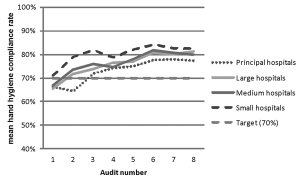In 96 Australian hospitals average hand hygiene compliance rates increased from 67% to 80% during the study period (2010–2013), with 46% of hospitals achieving target compliance rates of 70% in audit 1, versus 92% in audit 8.
Average hand hygiene rates at small hospitals were 7.8 percentage points (pp) higher than those at the largest hospitals.
Mumford et.al analyzed the relationship between hand hygiene compliance rates and accreditation outcomes in order to test the suitability of hand hygiene as an indicator of accreditation outcomes. Their hypothesis is that hospitals with better accreditation outcomes and infection control scores than others reflect organizational processes that support a positive culture towards improving quality and safety, and therefore they would achieve higher hand hygiene compliance rates.
Hand hygiene assessment is an integral component of the infection control standards used to evaluate whether Australian hospitals are compliant with accreditation standards. Hand hygiene compliance rates have been validated as a potential process indicator for accreditation outcomes. Moreover, HAI are recognized as a leading cause of increased morbidity and healthcare costs. In Australia, the most recent figures available indicate that HAI resulted in an extra two million bed days in 2005, with estimated additional costs of $A21 million from post-discharge surgical infections.

Mean hand hygiene compliance rates by audit and hospital peer group, 2010–2013